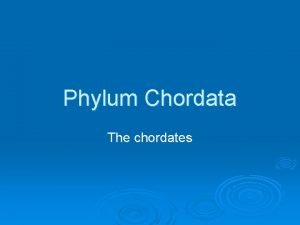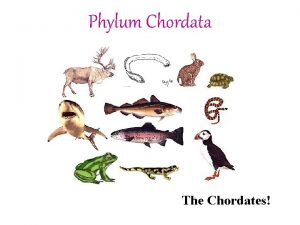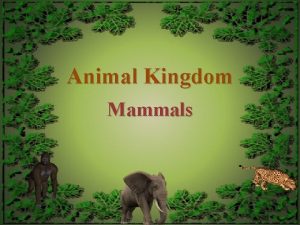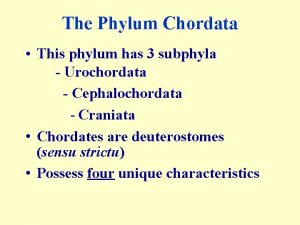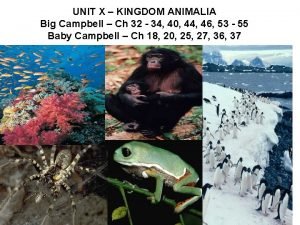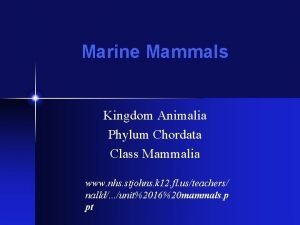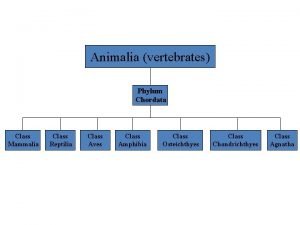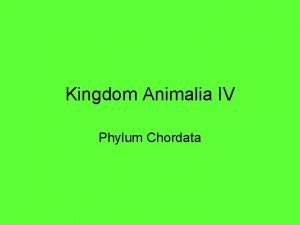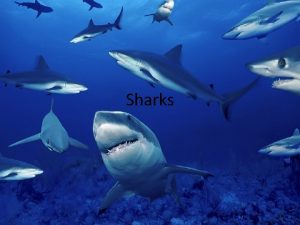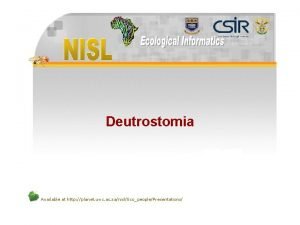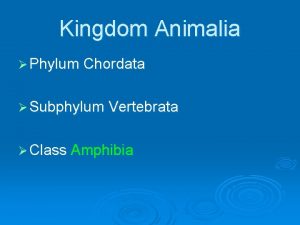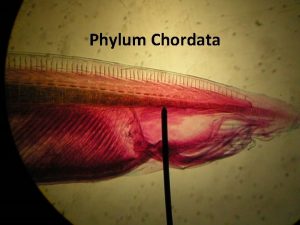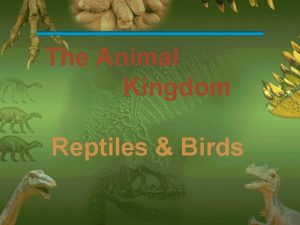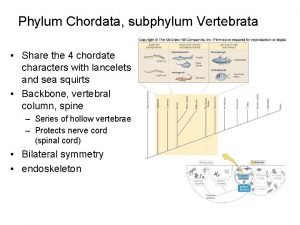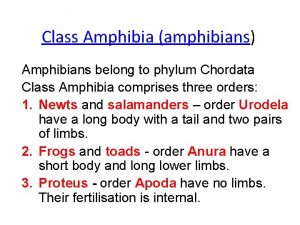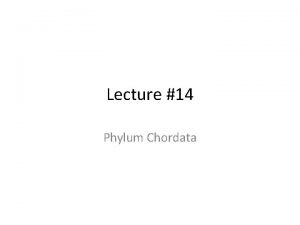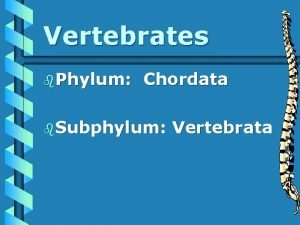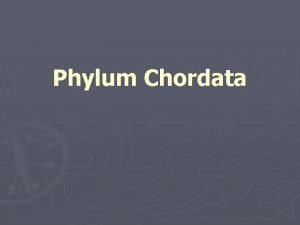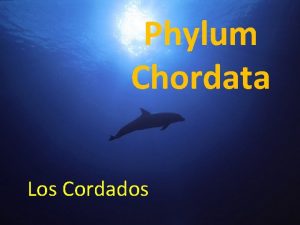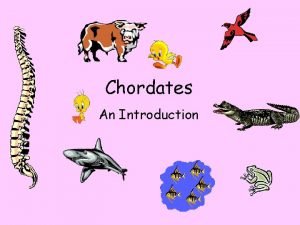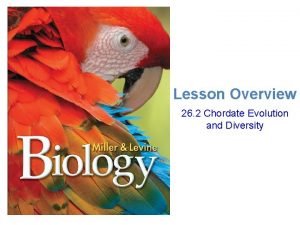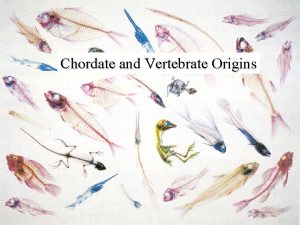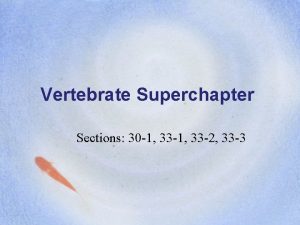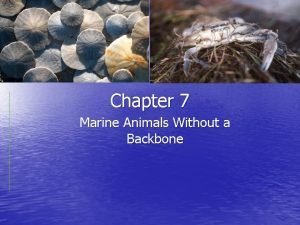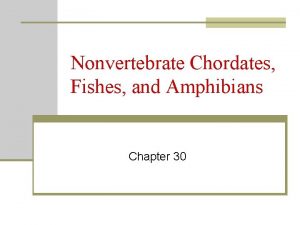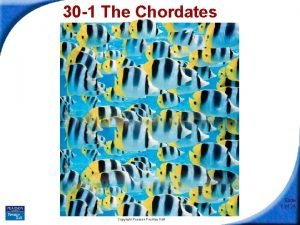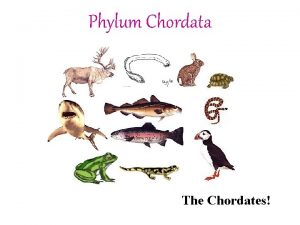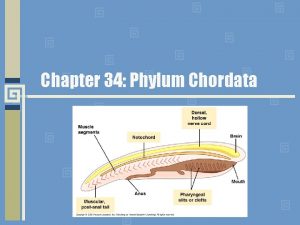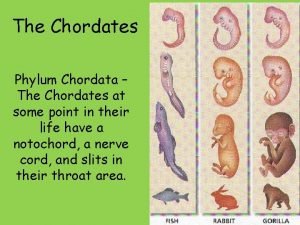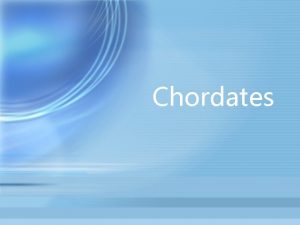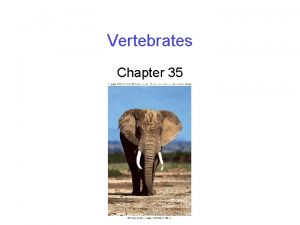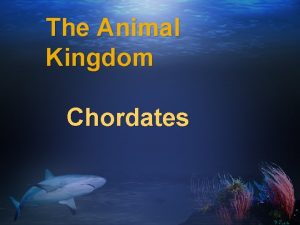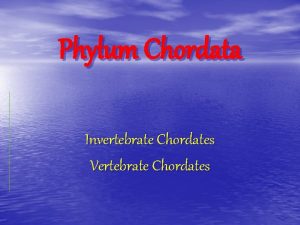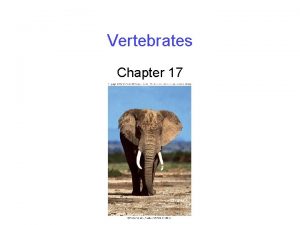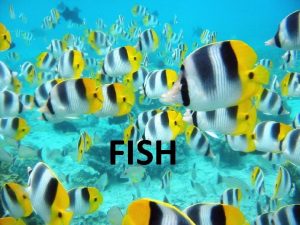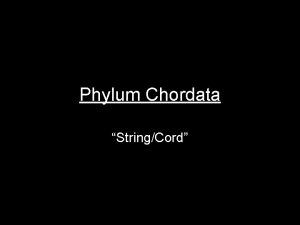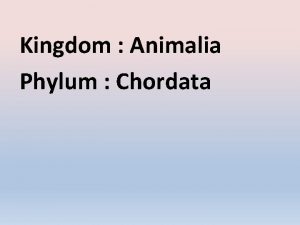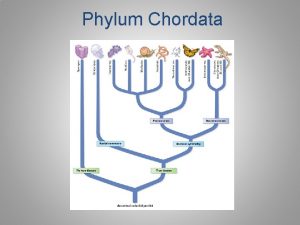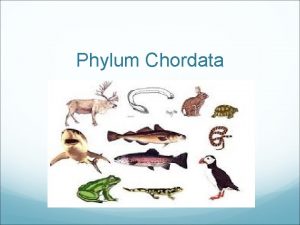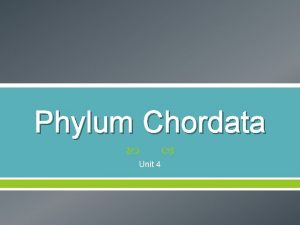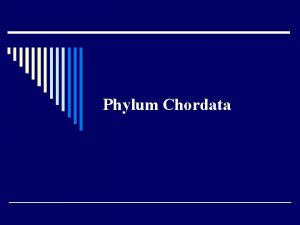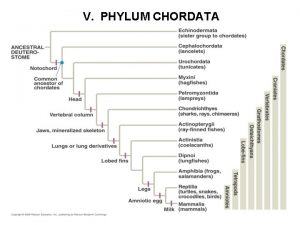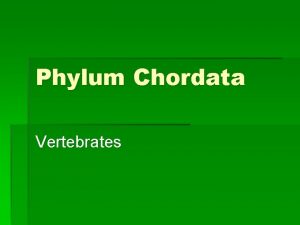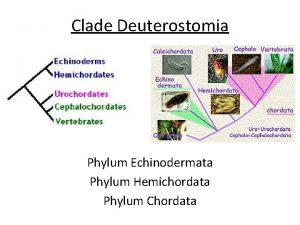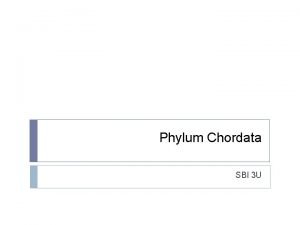Phylum Chordata Phylum Chordata Chordates have for at




























- Slides: 28

Phylum Chordata

Phylum Chordata: Chordates have, for at least one stage of their life: • A dorsal (top), hollow, nerve cord • A Notochord – a long supportive “backbone” • Pharyngeal pouches – gills or gill slits • A tail Chordates are divided into 2 groups: 1. Nonvertebrate Chordates 2. Subphylum Hollow Notochord nerve Vertebrata (no vertebrae) (have vertebrae) -Subphylum Urochordata -Jawless Fish Tail -Subphylum Cephalochordata cord -Class Pharyngeal pouches Chondrichthyes -Class Osteichthyes -Class Amphibia -Class Reptilia -Class Mammalia

Kingdom Animalia is divided into two groups Vertebrates Invertebrates Phylum Chordata is divided into groups Nonvertebrate Chordates Subphylum Vertebrata includes Subphylum Urochordata Cephalochordata Tunicates Lancelets Jawless Fish Class Chondrichthyes Lampreys & Hagfish Sharks & Rays Class Osteichthyes Bony fish Class Reptilia Class Mammalia Reptiles Mammals Class Amphibians

Diversity of Phylum Chordata

Phylum Chordata: Nonvertebrate Chordates Subphylum Urochordata • • Tunicates “Sea Squirts” Marine filter-feeders Although do not have vertebrae, still have a hollow nerve cord, notochord, pharyngeal pouches, and a tail Subphylum Cephalochordata • • • Lancelets Live on sandy marine bottom Catch food in mucus of mouth, swallow mucus for digestion • No heart, blood circulates by contracting blood vessels • Although do not have vertebrae, still have a hollow nerve cord, notochord, pharyngeal pouches, and a tail

Phylum Chordata: Subphylum Vertebrata Jawless Fish: Lampreys & Hagfish Class Chondrichthyes: Sharks & Rays Class Osteichthyes: Bony Fish Class Amphibia: Amphibians Class Reptilia: Reptiles Class Mammalia: Mammals

Phylum Chordata: Subphylum Vertebrata: Jawless Fish Lampreys (Superclass Agnatha) • Present in North American waters • Parasites that attach to other fish • Circular disk mouth has many teeth and a rasping tongue that scrapes away flesh then feeds on tissues and fluid Hagfish (Superclass Agnatha) • Lack eyes and have 4 -6 tentacles around mouth • Feed mostly on dead or dying fish • Use a toothed tongue to scrape away a hole • Able to tie themselves into knots

Phylum Chordata: Subphylum Vertebrata: Class Chondrichthyes Cartilaginous Fish • Sharks, Rays (some are electric) & Skates, Sawfish, & Chimaeras • Skeleton made of cartilage not bone, rough skin have tooth-like scales and feel like sandpaper • Most have gill slits • 350 different species of sharks, have thousands of teeth arranged in several rows • Some sharks are filterfeeders • The largest of Rays feed on plankton

Phylum Chordata: Subphylum Vertebrata: Class Osteichthyes Bony Fish • Skeletons made of hard calcified tissue called bone • Respire using gills Brain Gills Operculum Spinal cord • Detect gentle vibrations using sensitive receptors that form the lateral line system • Maintain buoyancy with an internal, gas-filled organ called a swim bladder

Phylum Chordata: Subphylum Vertebrata: Class Osteichthyes Bony Fish • Ray-finned fish • Most diverse of all Chordata Salmon Trout Sturgeon Bluegill Northern Pike Gar Smallmouth Bass Walleye Catfish Largemouth Bass Crappie

Phylum Chordata: Subphylum Vertebrata: Class Osteichthyes Largemouth Bass Smallmouth Bass

Phylum Chordata: Subphylum Vertebrata: Class Osteichthyes Tuna Bony Fish Eel • Ray-finned fish (Marine) Lion Puffer Dolphinfish Angel Marlin Tang Clown Sea Horse Angler fish

Phylum Chordata: Subphylum Vertebrata: Class Osteichthyes Bony Fish • Lobe-finned fish • Very rare, Lungfish, (does not have lungs) uses it’s modified swim bladder which also diffuses oxygen • Thought to be extinct millions of years ago, the prehistoric Coelacanth • Natives on the island of Madagascar have been accidentally catching them in fishing nets down in the far depths for centuries • Unable to live in captivity

Phylum Chordata: Subphylum Vertebrata: Class Amphibians • “Double life” • Most live in water as larva and on land as adults Leopard Frog • Adults have lungs, moist skin, lack scales and claws • External fertilization, eggs have no shells require moisture • Frogs & Toads (o. Anura) • Salamanders (o. Urodela) • Caecilians (o. Apoda) Mudpuppy Tree frog Bullfrog American Toad Fowler’s Toad External Gills!

Phylum Chordata: Subphylum Vertebrata: Class Amphibia Here’s a fun fact! Some frogs carry their eggs on their backs after until they hatch. This is a rare photo of the Gastric Brooding Frog. It has not been seen in the wild since the 1990’s and is thought to be extinct. The eggs are retained in the mothers stomach until mature enough to crawl out!

Phylum Chordata: Subphylum Vertebrata: Class Reptilia Reptiles Anole • Vertebrates with dry, scaly skin, lungs, and terrestrial eggs with several membranes 4 Groups: Gecko • Lizards & Snakes (Order Squamata) • Crocodiles & Aligators Iguana (Order Crocodilia) Crocodile Alligator Garder Coral snake Diamondback Chameleon

Phylum Chordata: Subphylum Vertebrata: Class Reptilia Reptiles • Vertebrates with dry, scaly skin, lungs, and terrestrial eggs with several membranes 4 Groups: • Turtles & Tortoises (Order Testudines) • Tuataras (Order Sphenodonta) Box Tortoise Painted Leatherback

Phylum Chordata: Subphylum Vertebrata: Class Reptilia Myth Buster #1 Snakes do not “dislocate” their jaws when swallowing. Any herpetologist will explain that their jaws can “expand” but the joints do not “dislocate” and then “relocate” afterwards.

Birds! Nearly 10, 000 Species!

Birds! Most Reptiles have 3 chambered hearts, some have 4. Birds have 4 -chambered hearts and have scales (on their legs) but are different from reptiles for 2 main reasons: 1. Birds can maintain a constant internal body temperature. 2. Birds possess the unique structures called feathers (which are actually very complex in structure)

Birds, not Aves…REPTILES! Myth Buster #2 Taxonomists have debated back and forth over how to classify birds. Depending on the year of publication one book might list them in class Aves and another in class Reptilia. However! Herpetologists stand firm that since feathers are evolutionarily modified scales, the correct placement is in Class REPTILIA!

Phylum Chordata: Subphylum Vertebrata: Class Mammalia Mammals • All mammals are characterized by 2 notable features: Hair and Mammary Glands • Mammals nourish their young with milk, breathe air, are endotherms (generate their internal body heat), and have 4 -chambered hearts • Complex circulatory systems, excretory systems, and JAWS • Large brains and increased intelligence

Phylum Chordata: Subphylum Vertebrata: Class Mammalia Mammals • Use Lungs for Respiration

Phylum Chordata: Subphylum Vertebrata: Class Mammalia Mammals • Monotremes are mammals that lay eggs • Marsupials bear live young in an external pouch

Phylum Chordata: Subphylum Vertebrata: Class Mammalia Mammals • Placental Mammals bear young internally that obtain nutrients and oxygen, and exchange waste and carbon dioxide between the mother and embryo through the placenta

Phylum Chordata: Subphylum Vertebrata: Class Mammalia Elephants • Elephants are Matriarchal, the oldest female leads the pride around the African Savanna. • Elephants have large brains and great memories. • Therefore, the oldest elephants are the most important to the entire pride.

Phylum Chordata: Subphylum Vertebrata: Class Mammalia Elephants • Sadly, the oldest elephants also usually have the longest tusks and are victims of poaching. • Elephants exhibit emotion and actually line up to mourn the loss of a dead relative, each paying their individual respects.

 Phylum chordata notochord
Phylum chordata notochord Chordata images
Chordata images Aves kingdom
Aves kingdom Mesonychids
Mesonychids Tunicate
Tunicate Phylum chordata
Phylum chordata Family leporidae kingdom
Family leporidae kingdom Kingdom animalia phylum chordata
Kingdom animalia phylum chordata Phylum chordata class reptilia
Phylum chordata class reptilia What are chordata
What are chordata Are sharks chordates
Are sharks chordates Phylum chordata
Phylum chordata Phylum chordata class amphibia
Phylum chordata class amphibia Platyhelminthes notochord
Platyhelminthes notochord Animal kingdom phylum chordata
Animal kingdom phylum chordata Chordata subphylum
Chordata subphylum Phylum chordata class amphibia
Phylum chordata class amphibia Chordata classification chart
Chordata classification chart Chordata subphylum vertebrata
Chordata subphylum vertebrata What are the characteristics of chordates
What are the characteristics of chordates Capas germinales
Capas germinales This has 6 faces, 12 edges and 8 vertices
This has 6 faces, 12 edges and 8 vertices Animalia kingdom chordates and vertebrates
Animalia kingdom chordates and vertebrates Earliest chordates
Earliest chordates Protochordates and chordates
Protochordates and chordates Non vertebrate
Non vertebrate Marine chordates with no skeleton
Marine chordates with no skeleton Nonvertebrate chordates
Nonvertebrate chordates Nonvertebrate chordates
Nonvertebrate chordates
